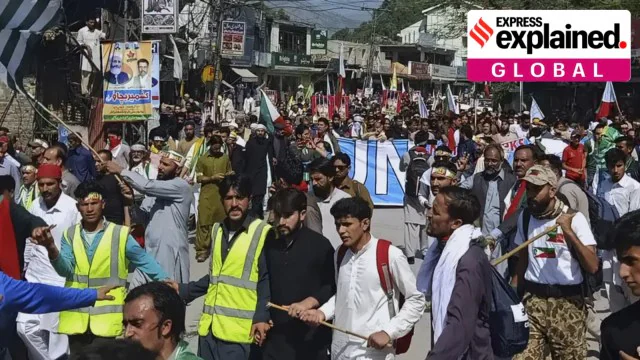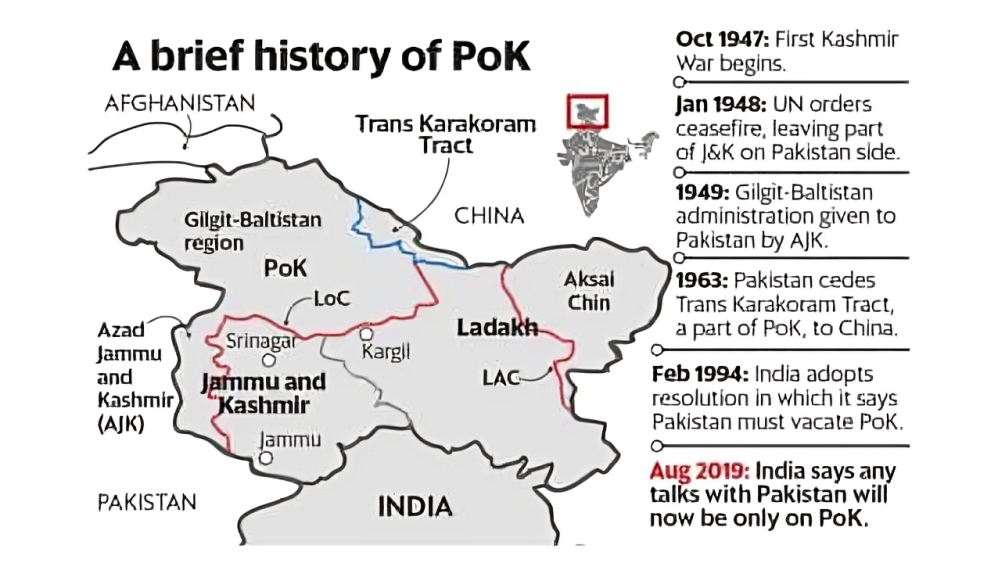Description

Copyright infringement not intended
Picture Courtesy: https://indianexpress.com/article/explained/explained-global/pok-protests-riots-inflation-food-crisis-pakistan-kashmir-9326378/
Context: Protestors in Pakistan-occupied Kashmir (PoK) are against rising costs of living exacerbated by Pakistan's economic crisis and trade disruptions with India.
Details
- The protests in PoK reflect a volatile situation driven by economic distress, feelings of neglect from the Pakistani government, and unresolved political tensions over the region's status.
Economic Crisis and Inflation
- High Inflation: Pakistan has been experiencing persistent and high inflation rates, with consumer prices above 20% and peaking at 38% in May 2023. This inflation erodes purchasing power, making essential goods and services increasingly expensive for the population.
- Rising Energy Costs: Increasing energy prices, including fuel and electricity, further strain household budgets and exacerbate the cost of living. The economic downturn caused by rising energy costs impacts businesses and households alike, particularly in regions like PoK.
Trade Disruptions and Economic Impact
- Customs Duty Hike by India: Following the Pulwama terror attack in 2019, India imposed substantial customs duties (up to 200%) on Pakistani goods. This measure significantly reduced Pakistani exports to India, affecting traders in PoK who relied on cross-border trade for economic sustenance.
- Cease of Trade with India: Pakistan's decision to halt all trade with India after constitutional changes in Jammu and Kashmir in August 2019 further disrupted economic activities in PoK. This cessation of trade affected various sectors and contributed to economic hardships in the region.
Alleged Discrimination and Resource Allocation
- Power Distribution Disputes: Leaders in PoK have raised grievances regarding alleged discrimination in power distribution by the central government in Islamabad. Issues related to insufficient allocation of hydroelectric power generated from projects like Neelum-Jhelum highlight broader concerns about resource allocation and regional disparities.
- Budgetary Constraints and Mismanagement: The refusal to allocate additional resources for government employee salaries and essential services highlights financial constraints and potential mismanagement of funds. This situation exacerbates local discontent and contributes to broader economic dissatisfaction.

Social Unrest and Protests
- Economic Grievances: The recent protests in PoK, sparked by rising costs of living, highlight the growing frustration among the local population. Arrests of protestors and traders during strikes further escalate tensions and reflect underlying economic grievances.
Broader Economic Context
- Foreign Exchange Reserves Depletion: Pakistan's declining foreign exchange reserves, dropping from $20.1 billion in August 2021 to $2.9 billion in February 2023, indicate significant financial instability and vulnerability to external economic shocks.
- IMF Assistance and Economic Outlook: The International Monetary Fund's (IMF) projection of substantial financing needs ($123 billion over five years) highlights the urgency of addressing Pakistan's economic challenges. The shrinking GDP and stagnant stock market highlight broader systemic issues requiring comprehensive structural reforms.
|
The current crisis in PoK is the result of multiple economic concerns, including trade interruptions, inflationary pressures, claimed resource allocation gaps, and broader governance issues.
|
Pakistan-occupied Kashmir (PoK)
- Before 1947, Kashmir was a princely state ruled by a Hindu Maharaja, Hari Singh. When India and Pakistan gained independence, the Maharaja initially chose to remain independent. However, following tribal incursions from Pakistan, he signed the Instrument of Accession, aligning Kashmir with India.
- The First Indo-Pakistani War over Kashmir (1947-1949), resulted in a ceasefire line dividing the region between the two countries. PoK refers to the portion of Kashmir currently under Pakistani administration.
Current Status
- PoK is divided into two main territories:
- Azad Jammu and Kashmir (AJK): Administered by a civilian government with a president and a prime minister. However, real power is believed to lie with the Pakistani military and intelligence agencies.
- Gilgit-Baltistan: Previously known as the Northern Areas, it was directly administered by Pakistan until 2009 when it was granted limited self-governing status.
- The legal status of both territories remains disputed, with India claiming them as part of its territory. The Line of Control (LoC) serves as a de facto border between Indian-administered Kashmir and PoK.
- Reports by Human Rights Watch and Amnesty International highlight concerns about human rights abuses in PoK, including restrictions on freedom of speech and assembly, torture and arbitrary detention, and discrimination against religious minorities.
- The political system in PoK is considered to be under strong Pakistani influence. Political parties advocating for greater autonomy or independence for PoK face significant restrictions.
Strategic Importance
- PoK holds strategic importance for both India and Pakistan due to its geographical location. It borders Afghanistan, China, and India's Jammu and Kashmir.
- Pakistan views PoK as a vital link to China through the China-Pakistan Economic Corridor (CPEC) and a strategic buffer against India.
|
The future of PoK remains uncertain, tied to the larger issue of the Kashmir dispute between India and Pakistan. Resolution of the dispute requires dialogue and negotiation between both countries, while also considering the aspirations of the people of Kashmir, including those residing in PoK.
|

Source:
Indian Express
Wikipedia
|
PRACTICE QUESTION
Q. Both India and Pakistan rely heavily on the Indus River system for water resources. How does the ongoing border dispute in Kashmir impact water-sharing agreements and the potential for future conflict over water scarcity in the region?
|















